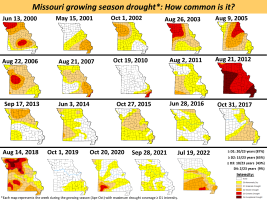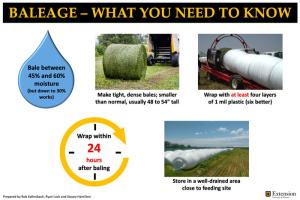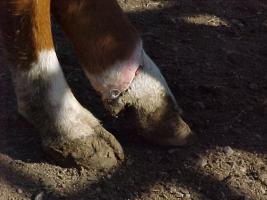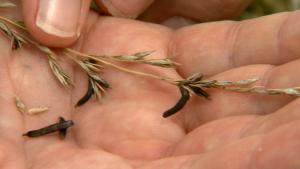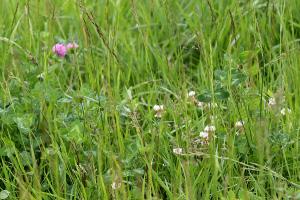Regional drought calls for winter feed strategies
MOUNT VERNON, Mo. – Drought in southwestern Missouri calls for long- and short-term feed plans for beef and dairy herds.University of Missouri Extension state dairy specialist Stacey Hamilton urges producers not to panic as local feed supplies dwindle. There are options to carry herds through winter until spring pastures green.
Drought recovery forage options
GALENA, Mo. – “If there was ever a year to focus on stockpiled tall fescue, this is it,” says Tim Schnakenberg, University of Missouri Extension agronomy specialist in Galena.
Apply fall nitrogen now to boost forage stockpiles
COLUMBIA, Mo. – University of Missouri Extension nutrient management specialist John Lory recommends applying fall nitrogen in mid-August to cool-season pastures.Despite drought conditions in much of the state, Lory says, “we need to get nitrogen applied now so we can take full advantage of the rains when they do arrive.”
Blister beetles reported in high numbers
COLUMBIA, Mo. – Farmers, livestock owners and gardeners across the state report that blister beetles are appearing in large numbers this summer, says Pat Miller, University of Missouri Extension agronomy specialist. Blister beetles produce a toxin that can harm livestock.The toxin, called cantharidin, can cause animals to become sick and even die. Cantharidin is a stable toxin, so even the dried remains of beetles in hay remain…
Drought requires feed efficiency in cattle
WEST PLAINS, Mo. – Low supplies of hay make feeding cattle a challenge.Elizabeth Picking, a University of Missouri Extension livestock specialist in southwestern Missouri, sees the effects of severe drought in her area – dwindling hay supplies, poor-quality hay, high prices and ponds going dry.
SW Missouri no stranger to drought in forages
WEST PLAINS, Mo. – Southwest Missouri farmers and livestock producers are no strangers to drought. In 2022, livestock owners face short-term and long-term challenges growing pastures for grazing and winter feeding.
Short forage supplies require producers to make tough decisions
COLUMBIA, Mo. – Dry weather and short pastures have reduced forage supplies, prompting livestock producers to ponder “could have, would have, should have” scenarios, says University of Missouri Extension livestock specialist Eric Meusch.Producers should try to match their herd needs to anticipated forage supplies, Meusch says. This requires planning before a drought. Many factors will be out of your control if you wait until drought…
Tough culling decisions come with drought, forage shortages
COLUMBIA, Mo. – With dry weather and short pastures, Missouri cow-herd owners face tough culling decisions. One way to match cows’ needs to available grass is to sell cows.Give careful thought to which grass eaters go first, says Eric Bailey, University of Missouri Extension beef nutritionist. Under drought stress, identifying those cows becomes urgent.
Nitrate, prussic acid poisoning follow drought
COLUMBIA, Mo. – Nitrates and prussic acid build up in forages to levels dangerous to livestock during drought.Livestock face severe illness and even death after eating affected forages, says University of Missouri Extension agronomist Jamie Gundel.Nitrates tend to concentrate in the bottom third of the plant. It shows in the plant’s stem and stalks more than leaves, Gundel says.
Corn silage as a forage
COLUMBIA, Mo. – An emergency feeding situation is shaping up for Missouri’s beef producers because of the drought. University of Missouri Extension recently hosted University of Wisconsin agronomist Joe Lauer on the MU Extension Forage and Livestock Hour to discuss his research on corn silage as a forage.
Silage-making reminders
SEDALIA, Mo. – While it is still too soon to sound the alarm on “drought,” parts of the state are becoming severely dry, said University of Missouri Extension livestock specialist Gene Schmitz.
Wheatlage or grain? New decision tool helps find the 'sweet spot'
COLUMBIA, Mo. – A new tool helps farmers decide the breakeven price for wheatlage compared to harvesting their wheat as grain.
Forage - Mission Possible?
COLUMBIA, Mo. – Interested in an impossible task? Try making dry hay in Missouri in early spring. But baleage can turn spring forage harvest in Missouri into “Mission: Possible.”
Evaluating costs and benefits of renovating endophyte-infected pastures
COLUMBIA, Mo. — Nearly 98% of Missouri’s pastureland is tall fescue infected with an endophyte that can cause fescue toxicosis in grazing livestock. Fescue toxicosis lowers reproduction rates, milk production, gain and weaning weights. It also causes health problems, including lameness and heat stress.By replacing toxic fescue with other forages, producers eliminate animal exposure to the harmful endophyte. You can start the process…
Converting from Kentucky 31 begins in the spring
GALENA, Mo. – Ernest Newton Fergus, a University of Kentucky forage specialist in the 1930s and 1940s, did the livestock industry a great favor when he propagated Kentucky 31 fescue, says University of Missouri Extension agronomist Tim Schnakenberg.
Get 'nearly free' fertilizer by frost seeding legumes
COLUMBIA, Mo. – High nitrogen prices make it especially important to consider frost seeding legumes this winter, says University of Missouri Extension state forage specialist Craig Roberts. “2022 is different because fertilizer costs have tripled,” Roberts says. “Consider legumes as nearly free fertilizer.” (See the Farm Progress article “Seasonal Fertilizer Prices” at bit.ly/33h4YD5.)
With high fertilizer prices, are you better off buying fertilizer or supplemental hay?
COLUMBIA, Mo. – Increases in fertilizer prices add to the cost of growing forage for grazing. This leads farmers to ask if they should buy hay or fertilizer, says University of Missouri Extension nutrient management specialist John Lory.Comparing the benefits of buying hay vs. applying fertilizer for better yields is complicated, but it is crucial to the bottom line, says Lory.
As temperatures drop, watch for fescue foot
MOUNT VERNON, Mo. – When temperatures fall, beef producers should watch for signs of fescue foot in their beef herds.“As the cold weather moves in, you are likely to notice some cows or yearlings on fescue pastures may be slow-moving early in the day,” says University of Missouri Extension livestock specialist Eldon Cole. This might be an early warning sign of fescue foot.
MU Extension agronomist offers tips to offset high nitrogen prices
GALENA, Mo. – If there was ever a time to do a soil test, this is it, says University of Missouri Extension agronomist Tim Schnakenberg. Rising fertilizer prices make it too expensive to guess on how to apply nutrients, says Schnakenberg.Soil tests can prevent buying and applying fertilizer where not needed. See the MU Extension publication “Soil Sampling Hayfields and Row Crops” at extension.missouri.edu/g9217.
Grow now, graze later to reduce winter feed costs
COLUMBIA, Mo.
Be on lookout for ergot
COLUMBIA, Mo. – University of Missouri livestock and forage specialists are reporting ergot infestations that can cause major losses in livestock, said MU Extension state forage specialist Craig Roberts.
Rising feed prices call for cutting the fat in cow-calf operations
COLUMBIA, Mo. – University of Missouri Extension beef nutritionist Eric Bailey says beef producers can offset rising feed prices with changes in their operations. “It’s time to literally cut the fat from cow-calf operations,” says Bailey.Rising corn and soybean commodity prices are making their way downstream to feed prices, putting a pinch on profits.
Legumes improve pastures, grazing and profits
STOCKTON, Mo.- Add legumes to grazing pastures to improve cattle performance and forage production, says University of Missouri Extension regional livestock specialist Patrick Davis.Frost-seed clovers and lespedeza now, Davis says. They grow well with cool-season grasses in Missouri and improve spring and summer pastures.
Frost seeding improves yield, quality
COLUMBIA, Mo. – Forage yield and quality improve when legumes are frost-seeded at the right time, says University of Missouri Extension state forage specialist Craig Roberts. Frost seeding, a method of broadcasting seeds over snow- or frost-covered pastures, improves poor pastures at a low cost. Seeds work their way into the soil and germinate as the ground freezes and thaws between winter and spring.
Without forage test, hay by any other name is just hay
COLUMBIA, Mo. – Mature hay is hay. It may be brome hay, prairie hay or any other type of hay. But in the end, it’s just hay until it’s been tested.Forage tests tell the tale of whether hay is of good quality and nutrient-rich, says University of Missouri Extension livestock specialist Gene Schmitz.


